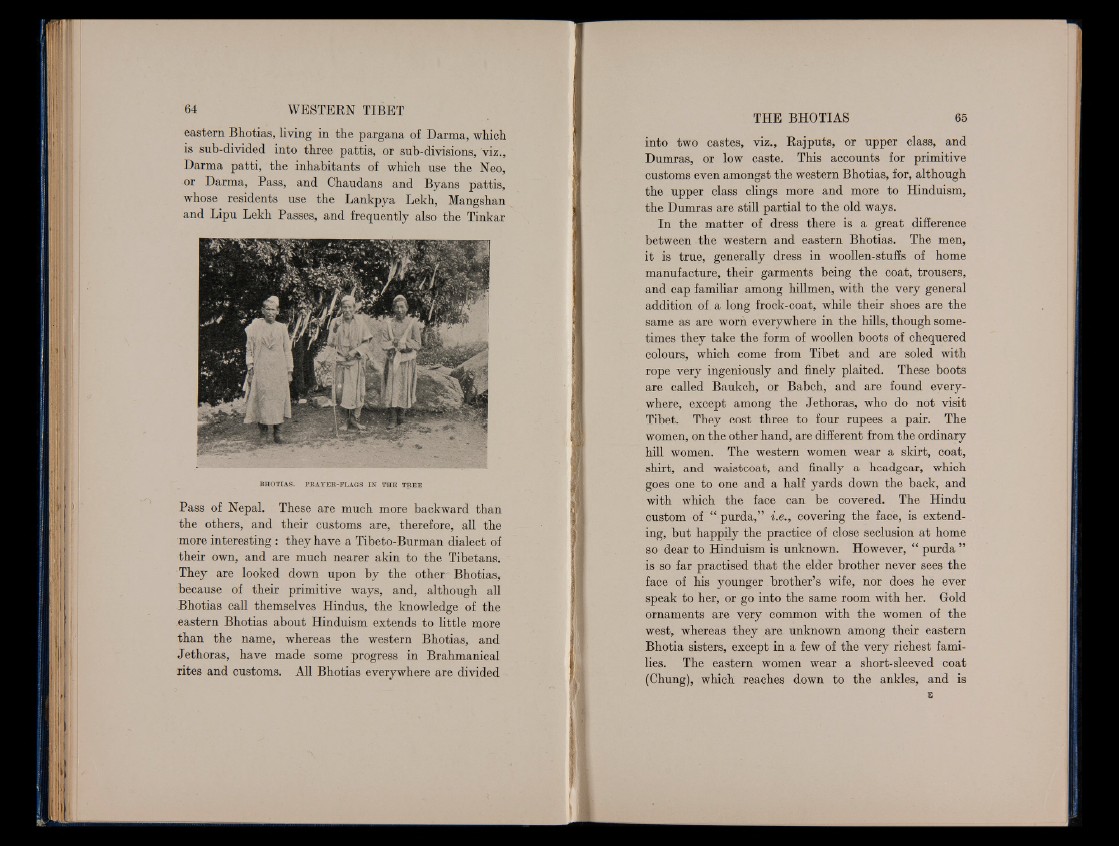
eastern Bhotias, living in the pargana of Darma, which
is sub-divided into three pattis, or sub-divisions, viz.,
Darma patti, the inhabitants of which use the Neo,
or Darma, Pass, and Chaudans and Byans pattis,
whose residents use the Lankpya Lekh, Mangshan
and Lipu Lekh Passes, and frequently also the Tinkar
BHOTIAS. PRAYER-FLAGS IN THE TR E E
Pass of Nepal. These are much more backward than
the others, and their customs are, therefore, all the
more interesting : they have a Tibeto-Burman dialect of
their own, and are much nearer akin to the Tibetans.
They are looked down upon by the other" Bhotias,-
because of their primitive ways, and, although all
Bhotias call themselves Hindus, the knowledge of the
eastern Bhotias about Hinduism extends to little more
than the name, whereas the western Bhotias, and
Jethoras, have made some progress in Brahmanical
rites and customs. All Bhotias everywhere are divided
into two castes, viz., Rajputs, or upper class, and
Dumras, or low caste. This accounts for primitive
customs even amongst the western Bhotias, for, although
the upper class clings more and more to Hinduism,
the Dumras are still partial to the old ways.
In the matter of dress there is a great difference
between the western and eastern Bhotias. The men,
it is true, generally dress in woollen-stuffs of home
manufacture, their garments being the coat, trousers,
and cap familiar among hillmen, with the very general
addition of a long frock-coat, while their shoes are the
same as are worn everywhere in the hills, though sometimes
they take the form of woollen boots of chequered
colours, which come from Tibet and are soled with
rope very ingeniously and finely plaited. These boots
are called Baukch, or Babch, and are found everywhere,
except among the Jethoras, who do not visit
Tibet. They cost three to four rupees a pair. The
women, on the other hand, are different from the ordinary
hill women. The western women wear a skirt, coat,
shirt, and waistcoat, and finally a headgear, which
goes one to one and a half yards down the back, and
with which the face can be covered. The Hindu
custom of “ purda,” i.e., covering the face, is extending,
but happily the practice of close seclusion at home
so dear to Hinduism is unknown. However, “ purda ”
is so far practised that the elder brother never sees the
face of his younger brother’s wife, nor does he ever
speak to her, or go into the same room with her. Gold
ornaments are very common with the women of the
west, whereas they are unknown among their eastern
Bhotia sisters, except in a few of the very richest families.
The eastern women wear a short-sleeved coat
(Chung), which reaches down to the ankles, and is
£